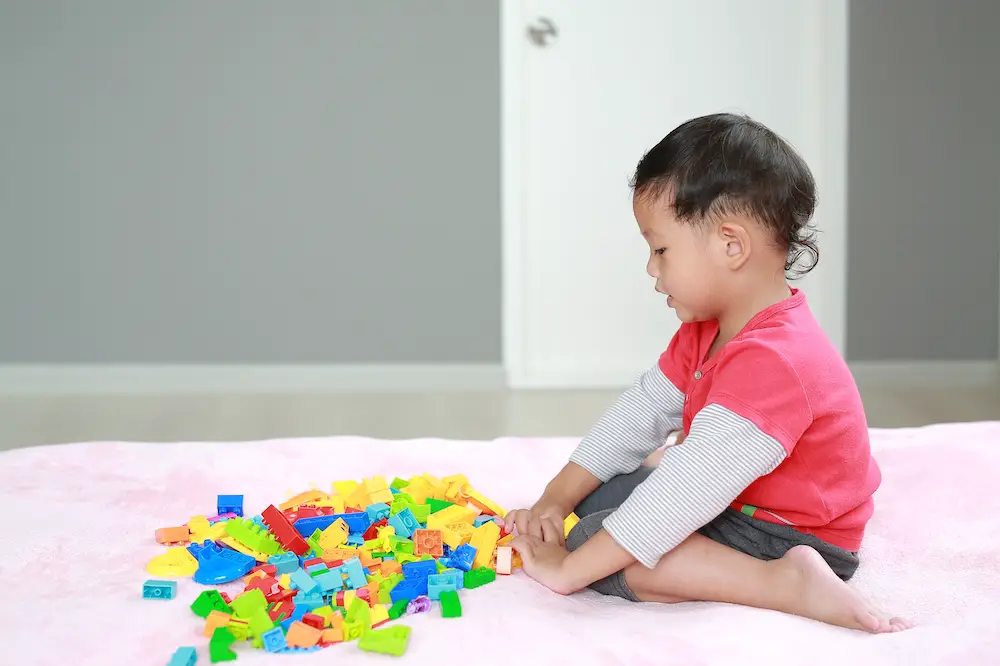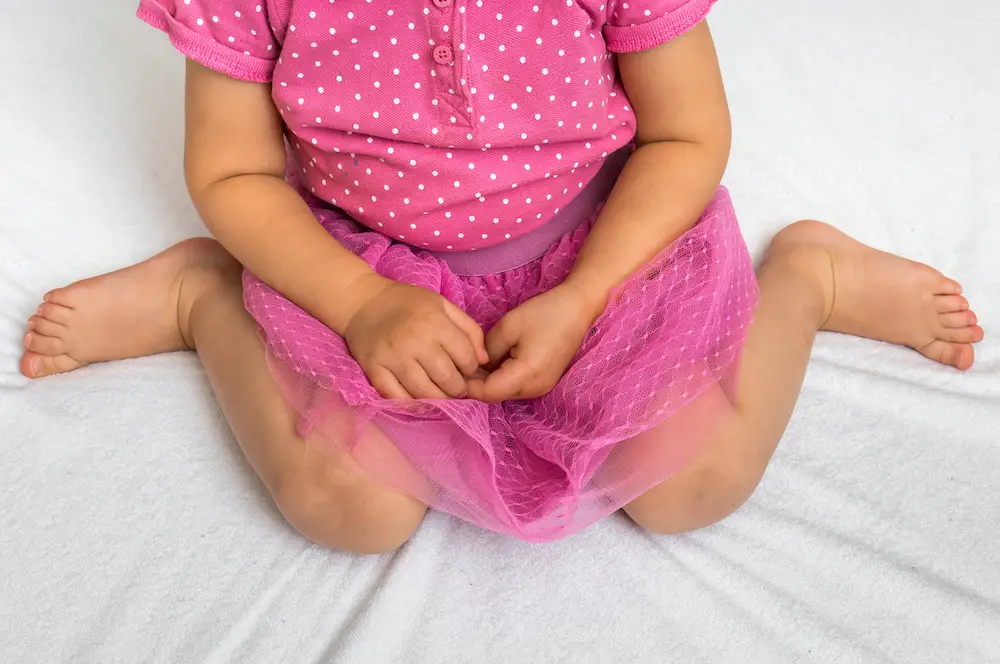As parents, we are often concerned about our child’s development, and one critical aspect of their overall growth is speech development. Speech and language skills are essential for social interactions, academic success, and well-being.
However, children may engage in certain habits and positions that can impact their speech development, and one such position is W-sitting.
So, today, we’ll talk about what W-sitting is and the relationship between W-sitting and speech delay.
What Is W-sitting?
W-sitting is a sitting position where children sit with their knees bent, feet behind them, and legs splayed out to each side, forming a W-shape. This sitting position is common among young children and toddlers, as it allows them to play with toys and reach for objects on the ground without losing their balance.
When Do Children Typically Begin to W-sit?
Children typically begin to W-sit around 9 to 12 months when they are learning to sit up independently. At this age, they may not have the core strength or stability to maintain a more upright position, so W-sitting can feel more comfortable and stable.
As they grow and develop better core strength and stability, they typically transition to other sitting positions that promote better posture and overall physical development.
Why W-sitting May Be a Concern
While W-sitting may seem like a comfortable and natural position for young children, it can have implications for their overall physical and speech development.
W-sitting can affect a child’s body in several ways. When a child sits in a W-position, their hips are in a position of internal rotation. It can cause tightness in the hip muscles and sometimes lead to hip dysplasia.
Sitting in a W-position can also affect the child’s joint stability. The W-position places excessive stress on the knees and ankles, which can lead to joint hypermobility or instability over time. This can increase the risk of injuries, such as sprains or dislocations.
The prolonged use of the W-sitting position can also contribute to the development of muscle imbalances. The muscles on the front of the hips, such as the hip flexors, may become tight and shortened.
Meanwhile, the muscles on the back of the hips, such as the glutes and hamstrings, may become weak and lengthened. This muscle imbalance can negatively affect the child’s gait pattern and overall movement mechanics.
Furthermore, W-sitting can cause the child’s core muscles to become weak, as they are not being engaged in this position. The core muscles are important for maintaining good posture, balance, and stability.
Weak core muscles can lead to poor posture, which can affect the child’s overall physical development and lead to problems with speech development.
What’s the Role of Weak Core Strength in Poor Speech Development?
Core strength plays a vital role in speech development for the following reasons:
Poor Posture
When a child has good core strength, they can maintain good posture, which can affect their ability to breathe properly. Breathing is essential for producing sounds and forming words.
When a child sits in a W-position, they may also be leaning forward or backward, which can affect the position of the tongue and jaw. The tongue and jaw position is essential for producing sounds and forming words.
Weakened Oral Motor Skills
Furthermore, good core strength can lead to better control of oral motor skills, which are important for speech development. The oral motor skills involve the movement of the lips, tongue, and jaw, and they are essential for producing sounds and forming words.
Weak core muscles can lead to weak oral motor skills, affecting a child’s ability to produce clear and understandable speech. Weak oral motor skills can affect the child’s ability to form words and produce sounds, negatively impacting speech development.

What Is Speech Delay in Young Children?
Speech and language development begin at an early age, and young children typically reach specific milestones as they grow and develop. These milestones include cooing, babbling, and saying their first words.
By age two, children typically have a vocabulary of around 50 words and can combine words to form simple sentences.
At three, they’re expected to speak in longer sentences and be understood by people outside their immediate family. By age four, children’s speech is more complex and can be understood by strangers.
So how would you know if your kid has a speech delay?
Common Signs of Speech Delay
Some children may experience delays in speech and language development, which can impact their social interactions, academic success, and overall well-being.
Common signs of speech delay include difficulty understanding simple instructions, not responding to their name, limited vocabulary, difficulty forming words or sentences, difficulty expressing thoughts or feelings, and repeating sounds or words.
Additionally, if a child has difficulty with fine motor skills, such as holding a crayon or using utensils, they may also have difficulty with oral motor skills, which are important for speech development.
Early Intervention for Speech Delay
Parents are encouraged to seek professional help with concerns about their child’s speech development.
Early intervention is critical for children with speech delay, as it can help them overcome their difficulties and catch up to their peers.
Speech therapists can work with children to develop their oral motor skills, improve their ability to form words and sentences and enhance their overall communication skills.
What Parents Can Do To Avoid the Effects of W-Sitting
With the many effects of W-sitting to your child’s development, including speech development, parents should also intervene as early as possible. Hence, here are some things parents can do to help their child:
Promote Other Sitting Positions
Encourage your child to sit in alternative positions that promote core strength and stability. Some examples include:
- Cross-Legged Sitting
Cross-legged sitting is a sitting position where the legs are crossed, and the feet are placed underneath the knees. This position helps engage the core muscles and promotes good posture and stability.
When sitting cross-legged, the child’s trunk muscles are activated as they work to maintain an upright position.
This engagement of the core muscles provides a stable base of support for the upper body, including the muscles involved in speech production. It allows for better alignment of the spine, which can positively impact breathing and phonation.
Additionally, cross-legged sitting encourages a more balanced weight distribution and reduces the risk of developing muscle imbalances or postural issues.
- Side Sitting
Side sitting involves sitting with one leg bent and the other leg outstretched to the side. This position also engages the core muscles and promotes a stable sitting posture.
By sitting with one leg bent, the child’s trunk muscles are required to provide support and maintain balance. This engages the abdominal and back muscles, strengthening the core and improving stability.
Side sitting can help develop the muscles necessary for proper articulation and speech production. It also encourages proper alignment of the jaw and tongue, which are essential for clear speech.
- Long Sitting
Long sitting refers to sitting with the legs outstretched in front of the body.
In this position, the child’s core muscles are engaged to maintain an upright posture and support the spine. The elongation of the legs and alignment of the body promote good posture and stability.
Long sitting helps develop the core muscles, improves coordination of the muscles involved in speech production, including the jaw, lips, and tongue, and improves overall body awareness and balance.
Have More Physical Activities and Playtime With Them
Engaging in physical activities and playtime is crucial for a child’s overall physical and speech development. Encourage your child to participate in activities like running, jumping, climbing, and playing sports.
These activities promote the development of gross motor skills, which are important for overall physical development.
Playtime also fosters imagination, creativity, and social interactions, positively influencing speech development. By incorporating more physical activities and playtime into your child’s routine, you provide them with opportunities to enhance their motor skills and communication abilities.
Encourage Proper Sitting Posture
Supportive seating is essential for promoting proper sitting posture. Provide chairs or stools that offer adequate back support and encourage your child to sit upright with their feet flat on the floor.
W-Sitting and Speech Delay: Yes, There’s a Relationship!
There is a relationship between W-sitting and speech delay in young children. W-sitting can affect the child’s overall physical development by impacting their core strength, stability, and oral motor skills, which are essential for speech development.
It is important for parents to monitor their child’s posture and speech development and to encourage them to sit in other positions that promote good posture and core strength.
Parents should also be aware of the common signs of speech delay in young children, such as difficulty understanding simple instructions, limited vocabulary, and difficulty forming words or sentences. This will ensure early intervention.
Early intervention is critical for children with speech delay, as it can help them overcome their difficulties and catch up to their peers.
By monitoring your child’s posture and speech development and seeking professional help, parents can help ensure that their child develops good communication skills and overall well-being.

